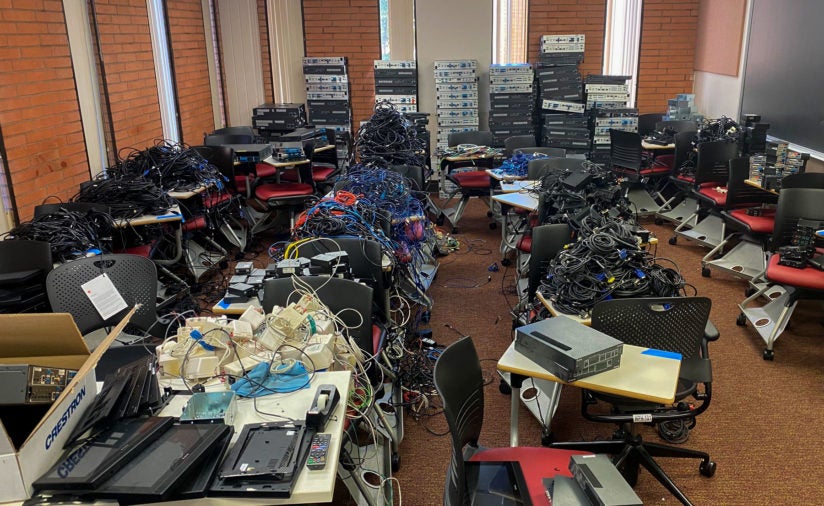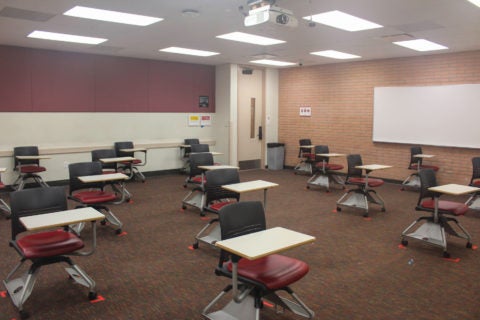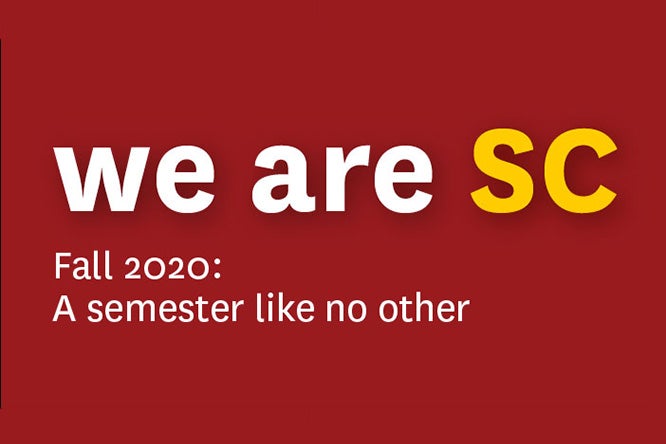Information technology quickly brings USC together during the remote learning era
Online collaboration tools, high-tech gadgets that create the classrooms of the future and a virtual hub for students are just the start, USC tech experts say.
When COVID-19 threatened to disrupt USC’s family ties and sense of connection this semester, experts in USC Information Technology Services quickly stepped in.
They had to provide a virtual space online where Trojan students, faculty, staff and alumni could get together while they stayed physically apart. And they had to do it fast.
“We moved up to fifth gear in March, and we haven’t really backed down from there,” said Veronica Garcia, associate chief information officer of application services. “Last semester was the disruptor, and it was about reacting and learning how to be online. This semester, we knew we had to provide more.”
Dozens of ITS developers, coders and technicians studied ways to use technology to bring Trojans together. They were joined by ITS communication and training experts to plan, promote and teach people how to use the new tech. The result: virtual learning for students this fall that crosses continents, time zones, disciplines and operating systems. And they pulled it off in just 22 weeks.
The staff upgraded technology in classrooms to enable instructors to livestream their classes from campus if they desire. They deployed programs like Blackboard, Zoom and Slack that help people share course materials and collaborate. At the same time, they brought all the tools together with other resources for students on a new website called Experience USC.
They’ve come a long way, but the ITS team knows more work remains.
“We’re going to continue to be adaptive and will evolve based on the public health considerations and feedback we receive,” said Susan Tincher, associate chief information officer of infrastructure services. “We’ll build upon these experiences and platforms to make the experience even better.”
Added Garcia: “This is definitely just the beginning. A lot of what we’ll learn will have a permanent impact on how we support students, staff and faculty. We’re always listening and we’re always looking for ways to improve.”
USC tech team introduces new learning tools and creates an online community
Online collaboration tools like Zoom can bring students, faculty members and university employees together in a virtual world. But USC tech leaders knew these tools had to connect with each other to work well. They also needed to pull in data from across USC, such as a user’s identity and relationship to the university.
“We can’t just introduce technologies if they don’t know who you are and what courses you’re in,” Garcia said. Behind every new technology are countless details the ITS staff had to sort through.
Students can find these new tools on the Experience USC website. The platform brings together about 2 million pieces of information related to the university’s 47,000-plus enrollees. When they log into Experience USC, students see event listings, ways to get involved with other students through clubs and organizations, and useful information on academics, wellness, career advancement and more.
“It’s all meant to create connection and community, to be one stop for students to post and share and interact, to find events that might be happening,” Garcia said. “All of that is powered by data.”
Educators and USC employees also can find resources online. They’re available on the university’s dedicated We are SC website — all in an effort to put these new tools at the campus community’s fingertips.
High-tech classrooms give instructors a sense of comfort in uncertain times
Fortunately, USC got a head start on shifting to a temporary online learning model. The university already had launched a broad effort to upgrade hundreds of classrooms for wireless sharing and hybrid teaching well before the pandemic.
“When COVID hit, people started asking me what we were going to do, and I could tell them: ‘We actually have a solution,’” said Joe Way, director of learning environments. “We’ve been planning for this. COVID just sped up our timeline.”

Since March, ITS workers have run wires, hung ceiling microphones, installed auto-tracking cameras and set up monitors in 226 classroom spaces across campus. The $2 million project features the latest high-tech equipment — and it’s all automated and touchless.
Because the upgraded classrooms are connected to the university’s course schedule, the system knows what class is being taught at any given time. Faculty members simply have to set down their laptop, log on and start streaming. Although instructors don’t necessarily have to go to campus, Way said many instructors appreciate the opportunity to teach in a familiar setting.
“Faculty members miss their classroom, and that makes sense,” he said. “They spend their entire career improving their craft in a certain environment, and this pandemic blew that all up for them. They are going to teach better when they are comfortable.”
The massive tech overhaul has drawn attention from other audiovisual experts around the country. A leading industry association recently gave the project a top award.
“These technologies have all existed, but nobody has ever put them all together on this level,” Way said. “A lot of people are watching us, and it’s pretty fun to have a mic-drop moment like this. The fact that we’re helping in a true emergency just makes it that much better.”
Training tools help instructors learn new tech and embrace online teaching
ITS experts also collaborate regularly with colleagues in the USC Center for Excellence in Teaching. Their training programs help instructors feel comfortable using new technology.
Educators need that training to get the most out of classroom software programs like Blackboard and Zoom, Garcia said. The team is also testing new technology like Labster, an augmented and virtual reality platform accessible via a computer or specialized goggles. Students can use the program to practice simulated experiments like building electrical circuits or preparing chemical solutions in an immersive 3D environment.
“We couldn’t just take a pass on labs,” Garcia said. “If labs go online, we need alternatives like this new tool.”
Another major task involved deploying the collaboration program Slack to students, professors and staff members across USC. Slack enables them all to send messages, share files or join a quick voice call. Many students already used Slack and similar platforms, Tincher said. “To extend these tools into the learning environment is something they’ve welcomed.”
Tech team’s message to USC community: We’re here to help

As the USC community gets used to learning and teaching online, the ITS team gathers feedback. Team members monitor daily requests for tech support to identify broad issues to address. A dedicated website brings together information on the latest digital technology for students, instructors and employees.
They also consult regularly with students. A survey seeking feedback about the online experience drew nearly 1,000 responses within 24 hours, said Garcia, who was heartened by the response.
“We’re putting students, staff and faculty at the center of our work,” she said. “We love to bring them technology that actually makes a difference. And if someone has a problem, we’ll be right there to help them solve it. Know that we’re here to listen and help.”




